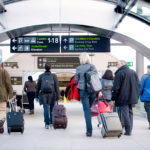 Airports and other public places can be confusing places at the best of times, but when people are stressed and time pressured, the ability to navigate effectively can be especially challenging. A new startup from the EIT Digital stable aims to provide the owners of airports and train stations with a better insight into how people navigate their facilities.
Airports and other public places can be confusing places at the best of times, but when people are stressed and time pressured, the ability to navigate effectively can be especially challenging. A new startup from the EIT Digital stable aims to provide the owners of airports and train stations with a better insight into how people navigate their facilities.
The company, known as Ariadne Maps, has begun its journey via a deal with the German rail company Deutsche Bahn, who will use the company’s indoor localisation technology to anonymously assess the movement of people throughout the station.
“Smartphones are never silent; unless they are totally switched off, they are always sending signals on different frequencies, even if they are in airplane mode. We capture these signals with our devices, which we install at the platforms, we triangulate them and analyse people movements,” the company explains.
Smarter wayfinding
They believe a particular problem for German rail companies, especially those located at the borders of the country, are distinguishing between passengers staying locally and those carrying on their journey elsewhere.
This has commercial implications, as the division of revenue between railway companies based in different countries is reliant upon being able to both identify the passenger and track their journey reliably.
Deutsche Bahn have only been able to do this to date by conducting regular surveys of passengers, but this has obvious limitations, not least of which is the relative infrequency of the surveys.
“Right now, we are installing our devices in one railway station. When this initial small-scale testing phase is over, Deutsche Bahn is committed to adopting our technology in 75 other stations and then possibly across their entire network,” Ariadne say.
The company hope that their technology can find uses in a range of sectors outside of transportation. For instance, they believe shopping centers can be interested in discovering how customers traverse their facilities, the shops they visit and the products they see.
There are also clear use cases in areas such as workplace design, with a growing emphasis being placed on collaboration between employees, there is a clear incentive to better understand how workers navigate the workplace and the people and places they come into contact with. The company are already working with a research facility in Antarctica to perform work of this nature.
For now however, transport is the main sector the company are targeting, and they have already begun working with Ferrovial, the company that manages Heathrow and other major global airports. The collaboration aims to help Ferrovial better understand how people move inside the airport.
“What they want to find out is the wait time: how much time it takes a passenger from the moment they enter the airport, to reach the gate; right now, there is no way of knowing this. Our method can generate detailed analytics, which can be used to mine patterns, such as identification of bottlenecks and hence act as a guide to reducing congestion,” Ariadne say.